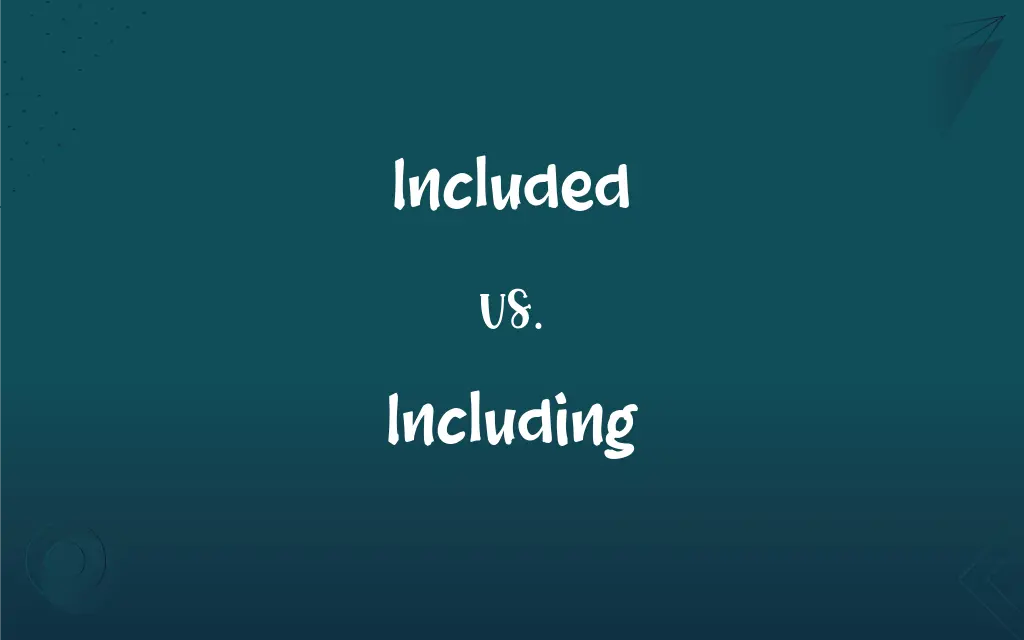Included vs. Including: What's the Difference?
Edited by Janet White || By Harlon Moss || Updated on November 6, 2023
"Included" is a past participle denoting something as part of a list or total, while "including" is a present participle suggesting something is encompassed within a list or group.

Key Differences
"Included" suggests that something is already a part of a group or total; it often refers to items within a fixed set. For example, "The price included taxes" means that taxes were part of the total cost. Conversely, "including" is used to introduce items or elements that are part of a larger group, often implying the list is not exhaustive. For instance, "The menu, including vegetarian options, caters to all diets," suggests that the menu contains vegetarian options among other items.
In the context of tense, "included" is typically used in the passive voice and refers to an action completed in the past. It often complements the main verb, providing a sense of completeness. On the other hand, "including" functions actively, linking additional information to the current context. It is dynamic, allowing for an open-ended list of items.
Grammatically, "included" can serve as an adjective or part of a verb phrase in perfect tenses. For instance, "All fees included" indicates that all fees have been counted in the total. In contrast, "including" is used as a preposition or as part of a participial phrase, leading to additional details or examples, such as, "Items including batteries are on sale."
In terms of function, "included" is definitive; it often finalizes a statement. When someone says, "Breakfast is included with the room," they confirm that breakfast is part of the room's offering. Meanwhile, "including" functions as an invitation to consider more than what has been mentioned; it opens the discussion for additional details.
"Included" suggests a past agreement or decision. When services are listed as "included," it indicates they are already incorporated into an offer or agreement. In contrast, "including" is used in current or ongoing contexts to specify elements or examples within a larger category, reflecting a real-time enumeration of parts.
ADVERTISEMENT
Comparison Chart
Part of Speech
Often used as an adjective or past participle.
Commonly used as a present participle or preposition.
Tense
Implies a completed action or state.
Suggests an ongoing action or current state.
Function
Indicates inclusivity within a set boundary.
Introduces elements or examples as part of a larger set.
Usage
Finalizes and confirms what is part of the total.
Suggests additionality or non-exhaustiveness.
List Implication
Denotes items are part of a definitive list.
Hints at an open or potentially expanding list.
ADVERTISEMENT
Example
"The package included a guidebook."
"The package, including a guidebook, was helpful."
Included and Including Definitions
Included
Given as part of a service.
Breakfast was included at the hotel.
Including
Encompassing or containing.
We have several colors available, including red.
Included
Incorporated as part of the whole.
Taxes are included in the final price.
Including
Factoring something in.
Total costs, including delivery, were calculated.
Included
Contained within something.
The kit included all the necessary parts.
Including
Mentioning specifically among others.
Everyone, including the coach, was present.
Included
Listed as part of a group.
The roster included all team members.
Including
Used to add something to a list.
The salad comes with a variety of nuts, including almonds.
Included
Covered as part of a deal.
Shipping is included with online purchases.
Including
Indicating the presence of.
The attendees, including the mayor, were impressed.
Included
(Botany) Not protruding beyond a surrounding part, as stamens that do not project from a corolla.
Including
To contain or take in as a part, element, or member.
Included
(Mathematics) Formed by and between two intersecting straight lines
An included angle.
Including
To consider as part of or allow into a group or class
Thanked the host for including us.
Included
Simple past tense and past participle of include
Including
Such as, among which; introducing one or more parts of the group or topic just mentioned.
All you have to do is to fill in the details, including your name and address and the amount you wish to give.
Included
Inclosed; confined.
Including
Introducing a finite clause.
Included
Enclosed in the same envelope or package;
The included check
FAQs
Can "including" imply a future context?
Yes, "including" can suggest something will be part of a future list or group.
Is "included" active or passive in nature?
"Included" is generally passive, denoting that something is already part of a group.
How do you know if "included" is an adjective?
If "included" describes a noun as part of a larger group, it's an adjective.
Does "including" always mean there are more items?
"Including" usually suggests there could be more items not explicitly listed.
Can "included" be used in present tense?
"Included" is the past participle; for present tense, "includes" is appropriate.
Is "included" used in legal documents?
Yes, "included" is often used in legal documents to specify included elements.
Is "included" always used in the past tense?
Yes, "included" often implies that something was part of a set in the past.
Can "including" be used to introduce a complete list?
"Including" often introduces a non-exhaustive list but can introduce complete lists in context.
Does "including" change form based on tense?
No, "including" does not change form because it is not bound by tense.
Can "including" start a sentence?
Yes, "including" can start a sentence when it introduces additional information.
What is the function of "included" in a sentence?
"Included" functions to confirm that something is part of a defined set or total.
Can "including" imply exclusivity?
"Including" does not typically imply exclusivity; it often indicates that there is more.
How does "included" differ from "inclusive"?
"Included" refers to specific elements that are part of a set, while "inclusive" is an adjective describing something as open to all or encompassing.
Does "included" have to follow a verb?
Not necessarily; "included" can follow a verb or be used as an adjective.
Are there synonyms for "included"?
Yes, synonyms include "comprised" and "contained."
Are there synonyms for "including"?
Yes, synonyms include "such as" and "comprising."
Can "including" ever be conclusive?
In some contexts, "including" can be conclusive, but it typically introduces additional, specific examples rather than closing a statement.
Can "including" be used without a following noun?
"Including" typically precedes the item(s) it is introducing and is rarely standalone.
Can "included" end a sentence?
Yes, "included" can end a sentence, especially when it's used as an adjective.
Is "including" a preposition?
"Including" can function as a preposition when it introduces a part of something.
About Author
Written by
Harlon MossHarlon is a seasoned quality moderator and accomplished content writer for Difference Wiki. An alumnus of the prestigious University of California, he earned his degree in Computer Science. Leveraging his academic background, Harlon brings a meticulous and informed perspective to his work, ensuring content accuracy and excellence.
Edited by
Janet WhiteJanet White has been an esteemed writer and blogger for Difference Wiki. Holding a Master's degree in Science and Medical Journalism from the prestigious Boston University, she has consistently demonstrated her expertise and passion for her field. When she's not immersed in her work, Janet relishes her time exercising, delving into a good book, and cherishing moments with friends and family.































































